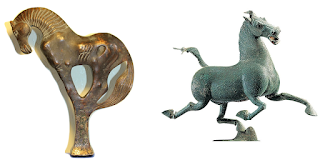Looking at Artifacts, Thinking About History
Heavenly horses, different cultural interpretations of the same image...To date, there are only two significant artifacts in the world dedicated to heavenly horses. One of them is a bronze horse galloping and a bird found in the Gansu province, which is kept in a museum in Lanzhou, China. The second is a bronze top horse from Ordos, which was found in the early twentieth century in the North part of China. Dating of the top showed that the artifact refers to the period between the IV-I century BC. The artifact is kept in a private collection.
It is quite possible that a bronze top horse would also be included in the list of significant historical artifacts prohibited for export to exhibitions outside China because of its high historical importance for the history of modern China.
According to historical documents, the Han Dynasty government later ordered the establishment of horse breeding centers in Gansu province in the hope of introducing the best genes of "heavenly horses" to Chinese breeds.
Thus, the role of horses in the development of Chinese civilization is huge. By understanding the strategic importance of horse breeding, breeding the best varieties of horses, the Han Empire was able to continue the development of its civilization. With the use of elite breeds of horses, the art of warfare was modernized, which made it possible to give a decent response to the raids of nomadic civilizations neighboring the empire. International trade received a new impulse in development - the Great Silk Road was laid.
The importance of the role of the horse is clearly reflected in the works of art of the Han period. The figure of the horse belongs to those times when Han began to spread its influence in the territory of the Gansu and Ordos, where the nomadic civilization challenged. It was necessary to obtain an important military and strategic resource - the best horses ready to compete with the cavalry of nomads. The Han Empire accepted the challenge. China was on the verge of new civilizational transformations brought to it by "Heavenly Horses".


Comments
Post a Comment